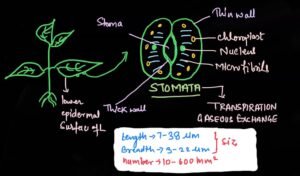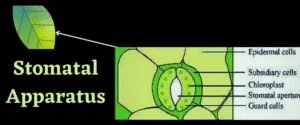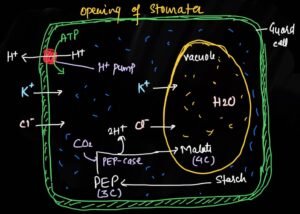Welcome to kashibiology.com In the previous post we have almost completed the chapter Microbes in Human Welfare.
In this post we have to learn all about the Stomata in detail for academic and medical competitive examination point of view.
Stomata
Stomata are the tiny pores also known as turgor operated valves, present on the leaf surface. The stomatal pore is formed by the two kidney shaped or bean shaped cells called guard cells.
Actually guard cells work like a guard which opens and closes the door.
In grasses the stomatal guard cells are dumbbell shaped.
The outer wall of the guard cell is thin which is located away from the stomatal pore and the inner wall of guard cell is thick located towards the stomatal pore.

In dumbbell shaped stomata, guard cells are thicker in the middle position while expanded areas are thin walled.
The surrounding cell is called subsidiary cell. Inside the guard cell a prominent nucleus and many chloroplasts are present.
In the cytoplasm the arrangement of cellulose microfibril in such a manner helps in the opening and closing of stomata.
Role of Stomata
In the plant system stomata play two important roles.
Number 1. It helped in the gaseous exchange that is the exit of photosynthetic oxygen and entry of photosynthetic carbon dioxide.
Number 2. Stomata involve the most important function called transpiration, most of the transpiratory process in the plant system done by stomata.
About 98% transpiration takes place by stomatal pore. The transpiration has a lot of work such as it pulls water in upward direction from the root. It helps in the cooling of plant surface area by 15 degree Celsius.
Number & Position
The number and position of stomata differ in monocot leaf and Dicot leaf. In monocot leaf numbers of stomata are almost equal on both upper and lower surface while Dicot leaf mostly stomata located on the lower surface of leaf.
Length ranges in between 7-38 micrometers and breadth is 3-12 micrometers. Number ranges in between 10-600 per millimeter square.
The difference in arrangement and the number of stomata in monocot and Dicot leaf is due to the orientation of the leaf.
In Dicot plant the orientation of Leaves is Dorsiventral manner while in monocot plant the arrangement of leaves in isobilateral manner that’s why such type of stomata is found in these plants.
Stomatal Apparatus
Stomatal apparatus is the collective term which includes stomatal pore, two guard cells and the surrounding subsidiary cells. Guard cells are the specialized epidermal cells.

Mechanism of Stomatal Movement
As we know stomata are turgor operated valves and the changes in turgor pressure or turgidity in the guard cell will help in opening and closing of stomata.
High turgor pressure will promote opening of stomata and less turgor pressure will promote closing of stomata.
Normally stomata are closed at night and open in daytime.
Different theories have been proposed for the opening and closing of stomata in which some are accepted while others are rejected.
Let’s start with some common important theories or hypotheses of stomatal movement and also will see which one is the most accepted theory of stomatal movement.
1-Guard Cell Photosynthesis theory
It was proposed by Schwendener.
According to this theory, photosynthesis in guard cells increases the concentration of carbohydrates.
Therefore water from the outer side moves to inside the guard cell by the process of endosmosis, which will increase the turgor pressure on the cell wall, therefore stomata will open.
Objection on this theory-
In most of the studies it has been found that photosynthesis activity of guard cell negligible therefore this theory has not been accepted.
2-Classical Starch Hydrolysis theory
It was proposed by Sayre in 1923 and later it was modified by Steward in 1964.
According to this theory the starch hydrolysis in the guard cell will help in the opening and closing of stomata.
Objection on theory
A number of objections have been raised which criticized the concept of classical starch hydrolysis theory of opening and closing of stomata.
Such as-
- Glucose is normally absent during opening of stomata.
- The second important point- the opening and closing of stomata is a fast process as compared to conversion of starch to sugar which is a slow process.
- What is the role of blue light in the opening and closing of stomata also has not been explained in this theory.
- It also does not explain how osmotic pressure increases in the guard cell.
3-Malate or Potassium ions Pump theory
It is the modern theory of opening and closing of stomata and proposed by Leavitt in 1974.
It is also known by potassium ion influx theory or potassium ion hydrogen ion exchange theory.
This theory explains how the pH of guard cells is raised, which affects the opening and closing of stomata.
Mechanism of opening and closing of stomata
Stomatal Opening (Day Time)
- In day time PH increases due to active absorption of hydrogen ions in guard cell from the chloroplast and mitochondria.
- CO2 assimilation by Mesophyll cell and Guard cell also favors the rising of PH in guard cell.
- Consequently the rise of PH causes hydrolysis of starch into an organic acid known as (PEP) Phosphoenol Pyruvate, which is the three carbon organic compound.
- Phosphoenol Pyruvate reacts with carbon dioxide (CO2) in the presence of Phosphoenol Pyruvate carboxylase (PEP-case) enzyme to produce 4 carbon containing organic acids that is Oxaloacetic acid (OAA).
- OAA is later changed into Malic acid.
- The Malic acid is also dissociated into Malate ions and hydrogen ions.
- Hydrogen ions pass out from the guard cell with exchange of potassium ions as well some chloride ions.
- Malate ions, potassium ions and chloride ions enter the vacuole.
- This causes increased osmotic concentration in the guard cell.
- Therefore Endo-osmosis takes place in the guard cell and water enters from the outside resulting, guard cells swell and create a pore.
- That is stomata open.

Stomatal Closing (Night time)
- At night time, hydrogen ions diffuse into the chloroplast of the guard cell, resulting in a decrease of pH of the guard cell.
- Malate ions in the guard cell cytoplasm react with hydrogen ions to form malic acid.
- Then the malic acid promotes leakage of potassium ions and chloride ions.
- Potassium ions dissociate from Malate in the guard cell and release from the guard cell.
- Abscisic acid (ABA- a plant growth inhibitor hormone) also promotes exchange between hydrogen ions and potassium ions.
- Loss of potassium decreases the osmotic concentration of the guard cell.
- Therefore Exo-osmosis takes place in the guard cell, and the guard cell shrinks, thus stomata closed.
Factors affecting on the movement of Stomatal Movement-
The factors can be divided into two groups.
Number one internal factor or plant-based factor
Number 2 external factors or plant independent factor
Plant independent factors including-
- Light quality, intensity and duration.
- Temperature of the environment
- Relative humidity
- Availability of water
- Any mechanical shock
- Carbon dioxide concentration oxygen concentration.
Plant based factors include-
- CO2 concentration and oxygen concentration inside the leaf
- PH value in guard cell and surrounding cell.
- Presence of growth hormone
- The concentration of minerals inside the plant body.
Conclusion
According to the above description it is clear that stomata are the tiny pores in the leaf surfaces in both Monocot and Dicot plants.
These tiny pores play an important role either directly or indirectly in plant growth and development and most important Plant survival.
I hope you understand the stomatal structure and its function and why these tiny pores are so called stomata.
Why they are very important in the plant body and what are the important Roles.
If any mistakes or any suggestion from your side please mention in comments
Thanks for reading this Post.
You may also enjoy to read this post.
Why RBC Die after 120 days “A love story between RBC & Macrophages”

